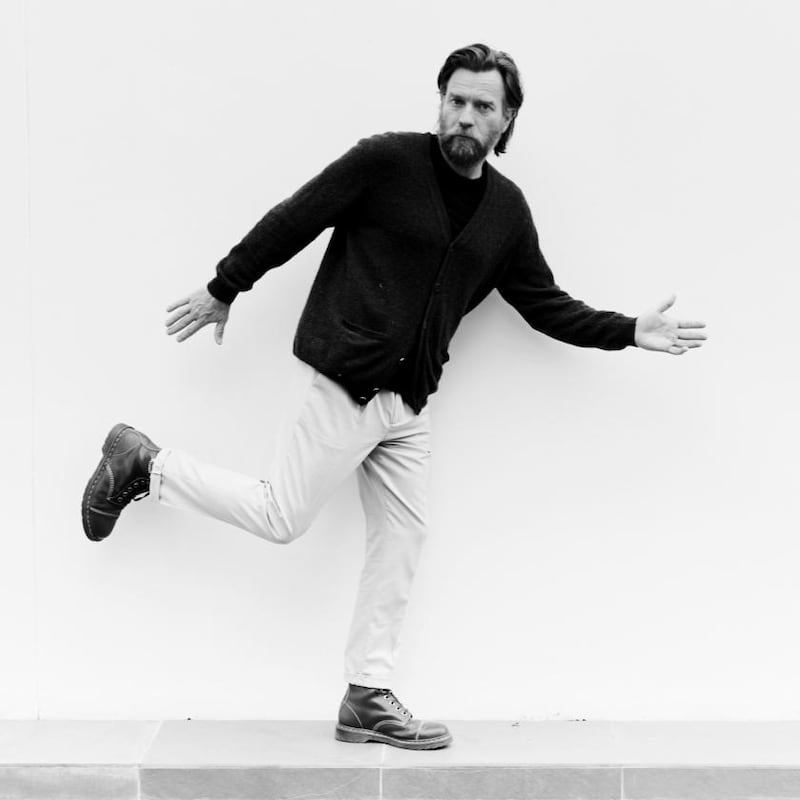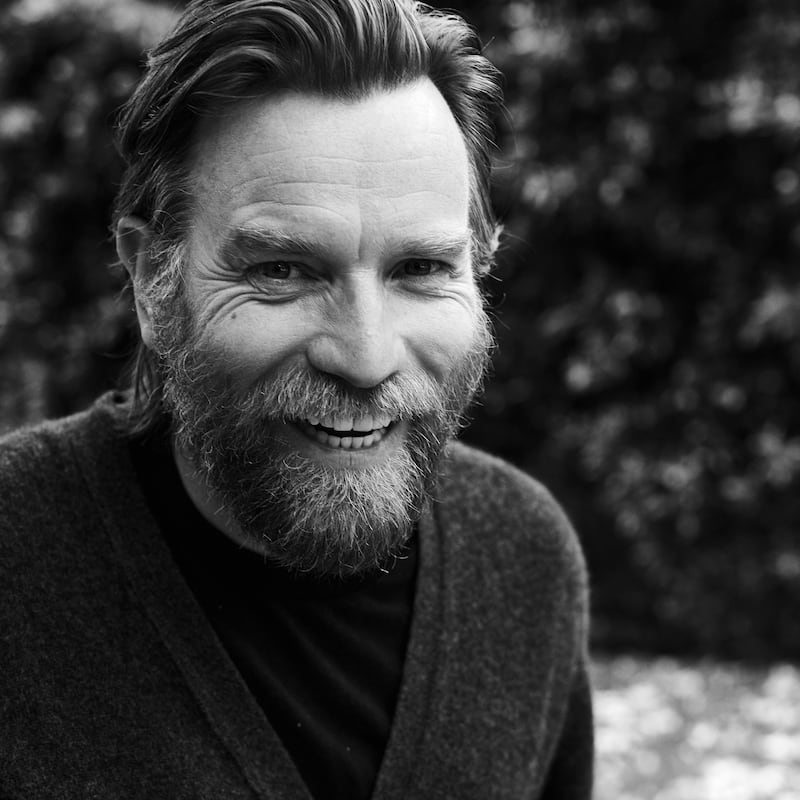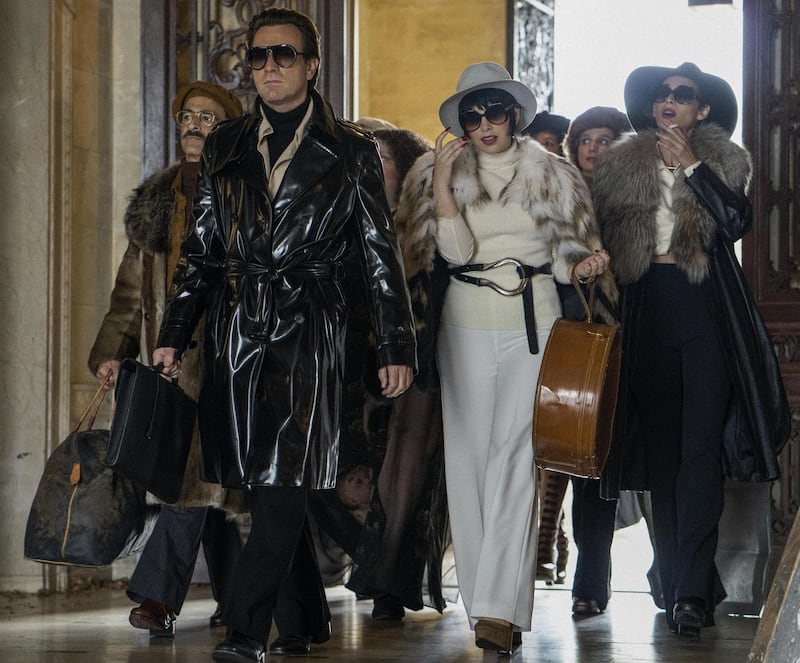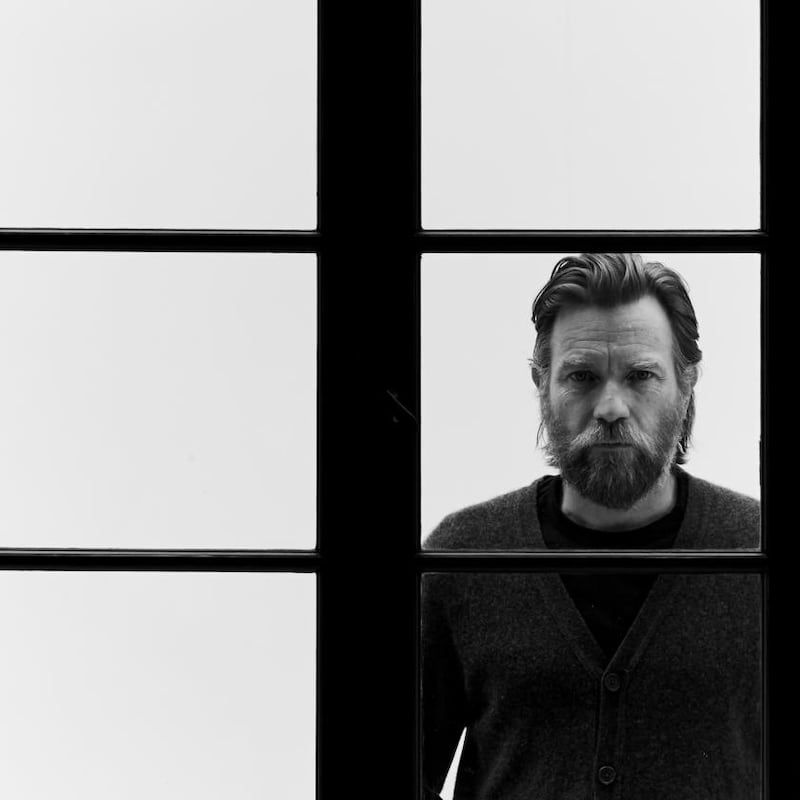When Ewan McGregor was but a wee lad in a sleepy town in Scotland in the 1970s, 5,000km away, in a Manhattan town house on East 63rd Street, Roy Halston Frowick was living on a diet of baked potatoes with beluga caviar, chilled Stolichnaya, rent boys and mounds of cocaine piled in Elsa Peretti silver ashtrays. (With silver straws to match.)
"I'd never heard of him," says a bearded McGregor, Zooming from his Los Angeles home. "I didn't know Halston at all." Then the actor got cast as the man with one name who lost the rights to that name, the man who was at the centre of a wild and tragic era in New York, the man who is known as the United States' first celebrity fashion designer. And McGregor, now 50, became so possessed with Halston in the eponymous Ryan Murphy miniseries coming to Netflix that sometimes he thought he was Halston, that he was the one who designed Jackie Kennedy's pillbox hat for the inauguration.
I don't know what my children's experience is of having a dad who's Obi-Wan Kenobi. I'm sure it can be pretty tedious in school and stuff. There's no discussion about Star Wars. I don't think they've ever watched them
"There were just little moments," McGregor says, "where I felt like, 'Oh, that was him.' There was, like, a little curse, an eye roll or something where I felt that was it." It's a tricky role since he has to play someone playing someone. Like Gatsby, Halston, who grew up in Indiana, created himself. He slicked back his hair, slathered on Guerlain bronzer, donned dark sunglasses, pulled on a black turtleneck and adopted a continental locution.
Halston would be gossiping and laughing with his assistant Tom Fallon as they walked to work when Halston was the custom milliner at Bergdorf's early in his career. Then, as soon as they pushed through the revolving doors, the voice and mien changed. "Hahl-ston had arrived," Fallon recalled in a documentary.
No matter how famous the designer got, no matter how supercilious and sleek he seemed, he never lost that sense of being an outsider. In the show, “H”, as he is known, calls his inner circle “a bit like little ships lost at sea ... a bunch of queers and freaks and girls who haven’t grown up yet”.
The director Matt Tyrnauer, who made a documentary about Studio 54, compares Halston to Cole Porter, also from Indiana. "Two Hoosiers who took Manhattan and defined cafe society in their respective generations," he says. "Both pretty out there with their sexual proclivities and both emblematic of the need for gays to flee and realise their cosmopolitan dreams."

Murphy's show explores Halston's volatile relationships with Victor Hugo, an escort who became his long-time companion, and Peretti, who was his model and a jewellery designer who was, futilely, in love with him. McGregor is now in a galaxy far, far away, making his Obi-Wan Kenobi TV series for Disney, but he is haunted by Halston. "I loved being him. It was so much fun."
Not quite as much fun as being the real Halston, since McGregor was smoking green-tea cigarettes instead of Trues, snorting sugary, vitamin-like Inositol instead of Bolivian marching powder and, because of Covid restrictions, conjuring disco fever with just 48 extras in the Studio 54 scenes.
“The part of me that’s a smoker thought, Okay, great, I can smoke again while I play Halston,” he says, with his raffish grin. But then: “The green-tea cigarettes are so horrible.”
When those who knew Halston in his heyday heard that McGregor was cast, they raised their manicured eyebrows. They could not picture the rough-and-tumble man-boy who likes to ride motorcycles and wield lightsabers as the grander-than-thou designer, whipping up tie-dye caftans, buttering up society matrons with a buffet of Ultrasuede wrap dresses, dispatching a plane from Manhattan to Montauk for his seafood lunch.
But when they watched screeners, they felt as though they were actually watching Halston. “That Scottish man pulled it off,” says André Leon Talley, the author of The Chiffon Trenches. “The way he pivots with the cigarette dangling between his two fingers and says ‘Bah-len-ciah-aaaaa-gah’, so it’s almost musical, with the ‘B’ floating on air, it was so perfect.”
"I cried," adds Talley, who was working at Andy Warhol's Interview magazine in those days and was a regular at Studio 54 and Halston's ultrachic grey lair, observing the Dionysian scene. "The story tells you the rise of the American dream and the ruin of the American dream. He was like Cary Grant, one of the greatest talents, up there with Saint Laurent. He dressed Jackie Kennedy, Lee Radziwill, Lauren Bacall. Then he flew too close to the sun, the Icarus myth. Sex and drugs and promiscuity ruined him, that Sodom and Gomorrah in the balcony and the basement of Studio 54. That Venezuelan call boy was his downfall."
Talley is referring to Victor Hugo, who like Halston invented himself and gave himself a new name, a play on his anatomy. “Believe me, he wasn’t reading French literature,” Talley says. “He was a grifter who clung on like a parasite, like a barnacle on a ship.”

Tom Ford, who says he was "a twinkie" at Studio 54 in the days when Halston hung out there with Liza Minnelli, Liz Taylor, Bianca Jagger and Warhol, is also impressed with McGregor and the show. When Ford was 18, a date took him to a gathering at Halston's house, which inspired him. "It's minimalist," he says, "but it's sensual and sexy." Four decades later, he bought the house, and he's now restoring it in the Halston image, reproducing the grey Paul Rudolph furniture on the bottom three floors and turning the top floor into a replica of Halston's ripe-cherry red office in the Olympic Tower.
“I really wish those walls could talk, or turn into video screens,” Ford says. “I wish I could see what happened in that house.” He says there was an old picture of Hugo peeing into a toilet in a bathroom that will now be used by his son, Jack. “I don’t think it would be appropriate to hang that picture over Jack’s toilet,” Ford says dryly.
Valerie Steele, the director and chief curator of the museum at the Fashion Institute of Technology, says she believes Halston's excess undermined his success in the fashion pantheon. "I think in a way we've been misled by the chaos of the Studio 54 scene to not think as highly of Halston as we should," she says. "I think he was one of the great designers." (Indeed, he will be featured in both parts of the Met's upcoming Costume Institute exhibit on American fashion.)
McGregor prepared for the role by having tea with Minnelli, who was Halston’s best friend, and obsessively watching Project Runway. He also worked with the show’s costume designer, Jeriana San Juan, to learn draping, pinning and cutting fabric. Since Halston scorned undergarments on his models, pinning was not without peril.
“I got a sewing machine,’’ he says. “I did a bit of sewing and I had, what do they call it? The dummy? I had one of those. I had some fabric. I bought some books.” He tried making himself some trousers. “I looked at trousers that I owned,” he says. “I was turning them inside out and just trying to figure it out.” He made the first pocket and was really impressed with himself. But then, when he put in the second pocket, he realised one was on the outside and one was on the inside. “They were cool. There was something Japanese about them. Very now, I thought.”
But he used such a heavy blue wool that they were too itchy to keep. Unlike his character, who strides around in long, double-faced wool red, cream and black trench coats, red pants and cashmere cardigans, the actor dresses in daily life with casual cool. “Ewan has a great sense of fashion. He’s really stylish,” says Baz Luhrmann, who directed McGregor in the 2001 film Moulin Rouge!, at a time when the actor was “at his most wild”.
Asked to describe what he is wearing on Zoom, McGregor pulls off his blue sweater to check the tag on his T-shirt, showing the top of his Calvin Klein underwear over his trousers. It is a funny moment, given the contempt Halston felt for the younger rival nipping at his heels. In one scene in the series, Halston calls Calvin Klein a "hack" and sneers: "There's something so Long Island about the whole thing." In another, he throws a glass full of scotch at the television screen when Brooke Shields comes on to purr, "You want to know what comes between me and my Calvins?"
McGregor laughs at his impromptu fashion commentary. “I’m wearing Buck Mason straight-cut T-shirt in stripes,” he says. “I’m wearing some indoor-outdoor slippers from huckberry.com. That is an amazing website. These trousers, I have no idea where I got these from, but they are like a drawstring pant. They’ve got no pocket and they’re made of canvas.”

His two oldest kids – he has four daughters with his former wife, Eve Mavrakis, a production designer – are following in his stylish footsteps. Clara, who is 25, and Esther, who is 19, starred in a Fendi ad together in 2018. Clara is a Wilhelmina model. "They are beautiful, aren't they?" McGregor says. "I was able to visit them on a shoot that they both did together in New York." After so many years where they tagged along with him, he says, it was "cool" to be the visitor in their world. "I actually went out and got them some sandwiches. There was no catering."
McGregor's home life became press fodder a few years back when he and Mavrakis split after 22 years of marriage. The actor is now in a relationship with Mary Elizabeth Winstead, his costar in season three of Fargo. His role playing both Stussy brothers in that series earned him a Golden Globe in 2018. Clara and Esther both expressed their dismay about the split on social media. Clara also wrote an Instagram post in 2019 about going to rehab to overcome a Xanax addiction, which has turned into a movie project, with her father producing, according to the Hollywood Reporter.
I ask McGregor how his own experiences with addiction factored into his portrayal as Halston. “I’ve been sober a long time and I’m interested in it,” he says. “It’s part of my life in terms of sobriety and having struggled with addiction.” Was his problem with alcohol exacerbated by drugs? “It was the ’90s,” he says with a dry smile. “It was lots of things.”
He was feeling so “miserable” by 2001 that he gave up alcohol and, for good measure, cigarettes. He misses the cigarettes more. “At the time, I thought it was cool and made me cool and makes you feel tough and hard,” he says. “Actually, who I am isn’t that. That’s just not who I was.”
He says that his ex-wife helped him and that other people talked to him about his behaviour. “I wasn’t getting away with it like I thought I was,” he says, adding: “It’s like somebody living inside you which is hellbent on destroying you, really. That’s what it wants.”

In the show, the Liza character, played by Krysta Rodriguez, tries to get Halston to come to the Betty Ford clinic with her, telling him gently: "The one thing you don't know how to do is stop." The actor had to relive all his experiences tracing Halston's spiral. (The show, directed by Daniel Minahan, sprang from the Steven Gaines biography, Simply Halston.) When Halston's secretary, Sassy Johnson, tells him he has gone through two weeks' worth of cocaine in a day, he screams at her to refill a Peretti dish. "Get it, Sassy!" he shrieks.
As he loses control, the designer begins lashing out at those closest to him as he realises he can't oscillate between high (Bergdorf) and low (JC Penney). Eventually his brand is taken over by the corporate parent of Playtex, which spurred him to comment in real life: "The folks from Planet Tampon landed on Planet Halston." (The brand has gone through many more iterations, including a stint when Harvey Weinstein and Sarah Jessica Parker were involved.)
McGregor had no problem with the bold sex scenes in Halston. He has always embraced onscreen intimacy with men and women, and never shied away from nudity. But he says it got boring for a long stretch when journalists only asked him about being sober and being naked, something he labels tabloid trash, with an expletive. It reached peak cringe in 2005 when Esquire referred to his penis variously as “man-root”, “lightsaber”, “Scottish sausage” and an “anaconda” – all in the same profile.
“Well, it’s a shame,” he says. “There’s a lot more to my life than that. I put up with it. Now it doesn’t happen so much any more.” Because they filmed during the height of Covid in Manhattan, the sex scenes were preceded with a lot of hand sanitiser, mouthwash and spitting into buckets.
Imagine you're 22 and you just got cast and you're on set with a male director and a male leading actor. It's, like, 'Just see what happens.' This poor 22-year-old girl – maybe she doesn't want what happens to happen
They also had an intimacy co-ordinator, which McGregor felt was an especially important development for young female actors. “Imagine you’re 22 and you just got cast and you’re on set,” he says. “The leading man is always 25 years older than you, and you’re suddenly with a male director and a male leading actor. Everyone’s always embarrassed about it. It’s, like, ‘Just see what happens.’ This poor 22-year-old girl – maybe she doesn’t want what happens to happen.”
With the intimacy co-ordinator, he says, “It’s literally like, ‘Are you happy to have your bum touched?’, ‘Are you happy for somebody to put their hand on your chest?’ ‘Are you going to kiss with tongues?’”
Last year, there was backlash to James Corden’s campy performance in another Ryan Murphy production, The Prom, with some condemning it as homophobic. And certainly, in less skilled hands, the portrayal of Halston – who had an intriguing blend of masculine and feminine qualities – easily could have gone off the rails.
I wonder if McGregor worried about the argument that straight actors shouldn’t play gay roles. “I haven’t walked in the shoes of somebody who’s had to hide their sexuality for fear of not getting roles, and I respect those that have,” McGregor says. “I will always have that argument with myself, and then with the director and the producers, before choosing to do something. It’s not like I don’t care. It’s not like I think it’s silly. I don’t. I do understand and I do get it. I hope people aren’t offended.”

Back in 1999, when he began playing Obi-Wan in the Star Wars prequels, McGregor readied himself to go from indie darling to big-budget star. But, as he says, “Those three films were pretty universally underwhelmingly received. People didn’t very much like them at the time. It was quite difficult to decide to do something that big and then to get involved in it and then to struggle through some of it and then for people not very much to like it. It wasn’t the experience I thought it was going to be, I suppose.”
He remembered being first shown around the props department and sets by George Lucas. "It blew my mind. I was young and had just done Trainspotting, and I believed in myself as a grungy, gritty urban actor, and there I was deciding to do one of the biggest franchises in the world."
Walking on set with Lucas, he observed the making of a submarine. “I looked at it, all excited, and said, ‘Oh, my God, will we go underwater?’ And George just looked at me and laughed and went, ‘It’s not even real, you know.’” The actor found the green-screen experience gruelling and was openly dismissive about a job that mostly entailed perfecting the Jedi frown and waving a saber. “There’s not a great deal of emotional excavating to do in the scene, and it can become very hard work,” he says.
He is Zooming from the bedroom of his daughter Anouk, who’s 10. He walks over to the bureau and picks up an Obi-Wan doll. “That’s me,” he says wistfully. “It’s never been touched. It’s never moved. It’s never been played with. I don’t know what [my children’s] experience is of having a dad who’s Obi-Wan Kenobi. I’m sure it can be pretty tedious in school and stuff. There’s no discussion about Star Wars. I don’t think they’ve ever watched them. They’re really not interested. I think it’s complicated for kids whose parents are famous or actors or whatever. It’s probably quite cool and quite tedious at the same time.”
Despite his "up-and-down experience" with the Star Wars movies, he got in touch with Disney and said: "Look, just so you know, if you ever think to do a spinoff with my character, I'd be up for it." Now, he sounds excited about the show he's doing for Disney+. He thinks his director, Deborah Chow, who directed episodes of The Mandalorian, is brilliant. He's even ready to go hang out with superfans at conventions. Still, he'll miss the dark side on East 63rd Street. "I was sad to know that I was going to have to let him go," McGregor says about Halston. He kept the black trench coat. – New York Times












